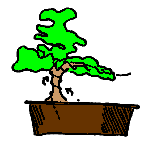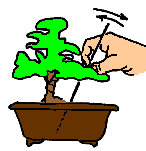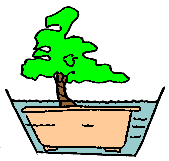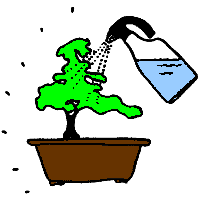
Pine Garden Bonsai Co.
20331 S. R. 530 NE
Arlington, WA 98223
phone (800) 746-3281, (360) 435-5995; fax (360) 435-4865
bonsai@premier1.net
Internet Bonsai Kit Care Guide
Copyright ©1996 Pine Garden Bonsai, Kate Bowditch
Welcome to bonsai
Allow about an hour to pot your bonsai starter. Select a work place near a source of water, where you can spill a little soil without concern. Follow the instructions from "A" to"I".
 A. First wire your bonsai: Sink the end of the wire into the soil next to the trunk of the bonsai starter. Wrap the wire around the trunk, spiraling up and out to the end of the longest branch. Bend gently to shape. The wire will maintain the bend. Cut off excess wire.
A. First wire your bonsai: Sink the end of the wire into the soil next to the trunk of the bonsai starter. Wrap the wire around the trunk, spiraling up and out to the end of the longest branch. Bend gently to shape. The wire will maintain the bend. Cut off excess wire.
B. Place the screen into the bottom of the container, covering both drainage holes. Now, cover this screen with a one inch layer of soil from the bonsai soil bag. (Do not tamp this soil down; leave it loose. )
C. Remove your bonsai starter plant from its growing container.
 D. Place your bonsai starter, attached soil and all, slightly off-center, in the bonsai container. This is traditional bonsai placement, toward the center, and two thirds of the way from the front to the back.
D. Place your bonsai starter, attached soil and all, slightly off-center, in the bonsai container. This is traditional bonsai placement, toward the center, and two thirds of the way from the front to the back.
E. Fill the remaining air spaces around your bonsai starter with more bonsai soil. Chopsticking: using a sharpened chopstick or a pencil (point side down), insert the tip into the soil to the bottom of the container. Move the free end back and forth a little to allow the soil to fall down into the roots. Do this in about six places around the tree. You may add more soil as you do this. When you are done, smooth the top of the soil, and firm gently with your fingertips.
 F. Soak your new bonsai in a pan of room temperature water that comes up to or over the lip of the bonsai container. After about two minutes, remove the container from the water and allow it to drain.
F. Soak your new bonsai in a pan of room temperature water that comes up to or over the lip of the bonsai container. After about two minutes, remove the container from the water and allow it to drain.
G. Water your bonsai by immersion at least once a week more if it becomes dry between waterings.
 H. Mist your bonsai with water daily.
H. Mist your bonsai with water daily.
I. Long term care: Soak your bonsai once a week, as above, a mist daily. Feed with a slow release fertilizer such as "Plant Sticks" from March to September.
Zelkova sinensis is an elm-like tree that bears its leaves all year round, or if exposed to cooler weather, will lose its leaves in the Fall and grow new ones in the Spring. In either case it can survive uneven treatment, such as a newcomer to bonsai may provide.
Juniper procumbens NANA, the world's most popular bonsai tree, is recommended for bonsai by its compact needle growth, attractive trunk, branch configuration and slow growth. Junipers like to be on the dry side, so let it dry out almost completely before watering it again. Until it gets to about one gallon size, your Juniper will do O. K. with the limited amount of light it gets indoors. After about three years of growth, make sure it is getting its five hours of indirect or filtered light daily.
For more complete plant descriptions see Care Guides on our home page .
Where to place your bonsai
Your bonsai needs about five hours of indirect or filtered sunlight each day. In the warmer months it will benefit from being outside, but not in the direct noonday or afternoon sun. During the summer, a few hours of morning sun, while the world is still cool, will benefit the tree.
Mist leaves daily to counteract the drying influence of artificial heat.
Go to our best in tools, containers, and stock.
Copyright ©1997 Pine Garden Bonsai. Last updated 29 Nov 97 drd
 Pine Garden Bonsai home page
Pine Garden Bonsai home page
 A. First wire your bonsai: Sink the end of the wire into the soil next to the trunk of the bonsai starter. Wrap the wire around the trunk, spiraling up and out to the end of the longest branch. Bend gently to shape. The wire will maintain the bend. Cut off excess wire.
A. First wire your bonsai: Sink the end of the wire into the soil next to the trunk of the bonsai starter. Wrap the wire around the trunk, spiraling up and out to the end of the longest branch. Bend gently to shape. The wire will maintain the bend. Cut off excess wire.
 D. Place your bonsai starter, attached soil and all, slightly off-center, in the bonsai container. This is traditional bonsai placement, toward the center, and two thirds of the way from the front to the back.
D. Place your bonsai starter, attached soil and all, slightly off-center, in the bonsai container. This is traditional bonsai placement, toward the center, and two thirds of the way from the front to the back. F. Soak your new bonsai in a pan of room temperature water that comes up to or over the lip of the bonsai container. After about two minutes, remove the container from the water and allow it to drain.
F. Soak your new bonsai in a pan of room temperature water that comes up to or over the lip of the bonsai container. After about two minutes, remove the container from the water and allow it to drain. H. Mist your bonsai with water daily.
H. Mist your bonsai with water daily. Pine Garden Bonsai home page
Pine Garden Bonsai home page